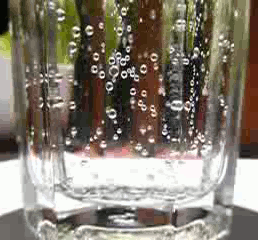
A soft drink is any water-based flavored drink, usually but not necessarily carbonated, and typically including added sweetener. Flavors used can be natural or artificial. The sweetener may be a sugar, high-fructose corn syrup, fruit juice, a sugar substitute, or some combination of these. Soft drinks may also contain caffeine, colorings, preservatives and other ingredients.

Carbonated water is water containing dissolved carbon dioxide gas, either artificially injected under pressure or occurring due to natural geological processes. Carbonation causes small bubbles to form, giving the water an effervescent quality. Common forms include sparkling natural mineral water, club soda, and commercially produced sparkling water.

Mineral water is water from a mineral spring that contains various minerals, such as salts and sulfur compounds. It is usually still, but may be sparkling (carbonated/effervescent).
Seltzer is carbonated water.

Schweppes is a soft drink brand that originated in the Republic of Geneva; it is made, bottled and distributed worldwide by multiple international conglomerates, depending on licensing and region, that manufacture and sell soft drinks. Schweppes was one of the earliest forms of a soft drink, originally being regular soda water created in 1783. Today, various drinks other than soda water bear the Schweppes brand name, including various types of lemonade and ginger ales.

Club soda is a form of carbonated water manufactured in North America, commonly used as a drink mixer. Sodium bicarbonate, potassium sulfate, potassium bicarbonate, potassium citrate, or sodium citrate is artificially added to replicate constituents commonly found in natural mineral waters and offset the acidity of introducing carbon dioxide gas.

Torbern Olaf (Olof) Bergman (KVO) was a Swedish chemist and mineralogist noted for his 1775 Dissertation on Elective Attractions, containing the largest chemical affinity tables ever published. Bergman was the first chemist to use the A, B, C, etc., system of notation for chemical species.

A soda fountain is a device that dispenses carbonated soft drinks, called fountain drinks. They can be found in restaurants, concession stands and other locations such as convenience stores. The artifact combines flavored syrup or syrup concentrate and carbon dioxide with chilled and purified water to make soft drinks, either manually, or in a vending machine which is essentially an automated soda fountain that is operated using a soda gun. Today, the syrup often is pumped from a special container called a bag-in-box (BiB).

S.Pellegrino is an Italian natural mineral water brand, owned by the company Sanpellegrino S.p.A, part of Swiss company Nestlé since 1997. The principal production plant is located in San Pellegrino Terme in the Province of Bergamo, Lombardy, Italy. Products are exported to most countries in Europe, the Americas, Oceania and the Middle East, as well as in Asia in Japan, Taiwan, Singapore and Hong Kong.

Selters (Taunus) is a municipality with 8,000 inhabitants north of Bad Camberg in Limburg-Weilburg district in Hesse, Germany.

The soda siphon, also known as the seltzer bottle, siphon seltzer bottle, or just siphon) is a device for storing and dispensing carbonated beverages while maintaining the internal pressure, thereby preventing it from going flat. The carbonated beverage is dispensed using the internal pressure of the bottle, so the setup is not a true siphon in its operation.
Borjomi is a brand of naturally carbonated mineral water from springs in the Borjomi Gorge of central Georgia. The artesian springs in the valley are fed by water that filters from glaciers covering the peaks of the Bakuriani mountains at altitudes of up to 2,300 m (7,500 ft). The water rises to the surface without pumping and is transported by pipes to two bottling plants in the town of Borjomi.
Jamnica plus LLC is a Croatian limited liability company which produces carbonated mineral water, as well as other bottled waters and soft drinks. It was founded on 18 October 1828, and operates as a part of the Beverages Group, an organizational division within the Fortenova Group.

Niederselters is an urban district (Ortsteil) of the community Selters in Hessen, Germany. Niederselters station lies on the Main-Lahn Railway. With Oberbrechen station, it is one of two stations in Brechen. Nearby is a Cistercian nunnery Kloster Gnadenthal, Hessen in 3 km.

Malvern Water is a brand of bottled drinking water obtained from a spring in the range of Malvern Hills that marks the border between the counties of Herefordshire and Worcestershire in England. The water is a natural spring water from the hills that consist of very hard granite rock. Fissures in the rock retain rain water, which slowly permeates through, escaping at the springs. The springs release an average of about 60 litres a minute. The flow rate depends on rainfall and can vary from as little as 36 litres per minute to over 350 litres per minute.

Agua Mineral Salus is a patented brand of mineral water produced by the company Salus SA. Its industrial base is in Lavalleja Department, Uruguay. The plant is located at the site of the mineral spring, 110 kilometres (68 mi) northeast of Montevideo and 10 kilometres (6.2 mi) west of Minas.
Sairme is a brand of naturally carbonated mineral water from springs of Sairme balneological resort area in Imereti region.
Armenia has a massive production of bottled mineral and spring water, with a large number of water bottling companies.

A soda machine or soda maker is a home appliance for carbonating tap water by using carbon dioxide from a pressurized cartridge. The machine is often delivered with flavorings; these can be added to the water after it is carbonated to make soda, such as orange, lemon, or cola flavours. Some brands are able to directly carbonate any cold beverage.















